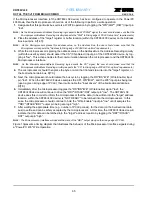
XRT86VL38
PRELIMINARY
xr
OCTAL T1/E1/J1 FRAMER/LIU COMBO
REV. P1.0.6
65
If the Microprocessor Interface (of the XRT86VL38 device) has been configured to operate in the PowerPC
403 Mode, then the Microprocessor should do all of the following to perform a write operation:
1.
Designate that this particular bus cycle is a WRITE operation by toggling the "WR*/R/W*" (R/W*) input pin
"low".
N
OTE
: As the Microprocessor/Address Decoding logic asserts the WR*/R/W* signal, the user should make sure that the
Microprocessor/Address Decoding circuitry respects the "R/W* to Rising edge of PCLK Set-up time" requirements.)
2.
Place the address of the "target" register or buffer location (within the XRT86VL38 device) on the Address
Bus input pins, A[14:0].
N
OTE
: As the Microprocessor places this address value, on the Address Bus, the user should make sure that the
Microprocessor respects the "Address to Rising edge of PCLK Set-up time" requirements.)
3.
While the microprocessor is placing the address value on the Address Bus, the Address Decoding circuitry
(within the user's system) should assert the CS* (Chip Select) input pin of the XRT86VL38 device, by tog-
gling it "low". This action enables further communication between the microprocessor and the XRT86VL38
Microprocessor Interface.
N
OTE
: As the Microprocessor/Address Decoding logic asserts the CS* signal, the user should make sure that the
Microprocessor/Address Decoding circuitry respects the "CS* to Rising edge of PCLK Set-up time" requirements.)
4.
The microprocessor should then place the byte or word that it intends to write into the "target" register, on
the bi-directional data bus, D[7:0].
5.
Next, the microprocessor should initiate the bus cycle by toggling the RD*/DS*/WE* (Write Enable) input
pin "low". When the XRT86VL38 device samples the CS*, WR*/R/W*, and the WE* input pins being low
(upon a given rising edge of PCLK), then it will enable the "input drivers" of the bi-directional data bus,
D[7:0].
6.
Immediately after the microprocessor toggles the "RD*/DS*/WE* (Write Enable) signal "low", the
XRT86VL38 device will continue to drive the "RDY*/DTACK*/RDY output pin "low". The XRT86VL38
device does this in order to inform the microprocessor that the data (to be written into the "target" address
location, within the XRT86VL38 device) is "NOT READY" to be latched into the microprocessor. In this
case, the microprocessor should continue to hold the "Write Enable" input pin "low" until it samples the
""RDY*/DTACK*/RDY" output pin being at a logic "high".
7.
After waiting the appropriate time (e.g., number of PCLK periods), for the data (on the bi-directional data
bus) to settle and can be safely accepted by the microprocessor. At this time, the XRT86VL38 device will
indicate that this data can be latched into the "target" address location by toggling the "RDY*/DTACK*/
RDY" output pin "high".
N
OTE
: The Microprocessor Interface will update the state of the "RDY" output pin upon the rising edge of PCLK).
Figure 10presents a timing diagram that illustrates the behavior of the Microprocessor Interface signals during
a "PowerPC 403" Write Operation






























